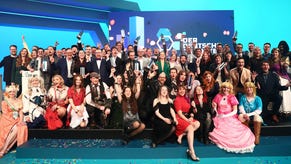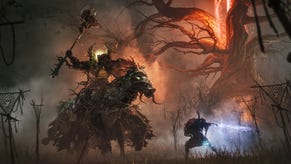Exploring the pay gap: What does the data really say about the industry's gender imbalance?
Full analysis reveals important questions about female representation across all industry levels
Official government data released on the gender wage gap has painted the UK games industry in a poor light, falling well below national averages and medians in terms of equality.
While the data is distinctly lacking in many areas, it does highlight clear patterns within the games industry. The dataset includes information on median and mean wage gaps, difference in bonus pay, and the ratios of women working within different levels of the company.
However, as only companies with 250 more UK staff were legally required to submit data, there are several notable omissions including Activision, Ubisoft, Ninja Theory, Nintendo UK, Sega, and Playground Games.
Even so, it offers a newfound level of transparency into the issues of equality in the modern British workplace, a move that was welcomed by UKIE CEO Dr Jo Twist.
"Importantly, businesses now need to be proactive and ensure they are taking the right steps in their policies and approaches so they can create the best opportunities for people and therefore an inclusive and diverse workforce, especially in senior leadership and management roles," she told GamesIndustry.biz.
It is important to note that the data is not detailed enough to provide an examination of equal pay for equal work. However, it does demonstrate how much less women earn on average in the British workplace and in the games industry in particular.
According to the data, the games industry has a median gender wage gap of 15.3%, compared to a national median of 9.7%. Companies where this disparity was most pronounced were Sumo Digital (34.5%), Rockstar (31.8%), and Codemasters (27.9%).
Inspired Gaming was the only company to actually pay women more than men (1%) while GAME and Namco boasted a 0% wage gap. The only other companies to come in under the national median were PlayNation (5.9%) and Microsoft (8.4%).
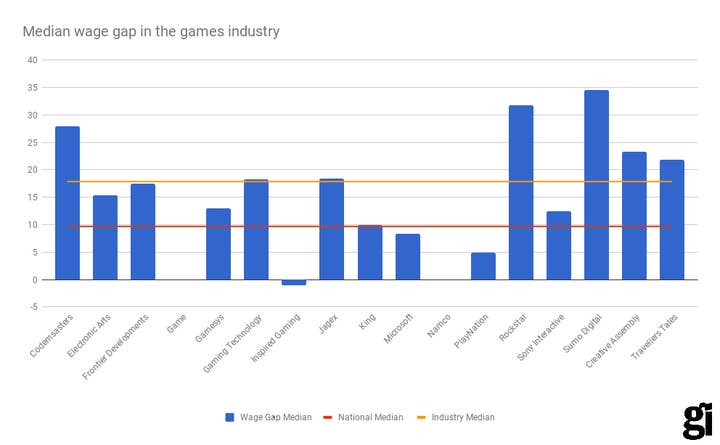
This disparity, along with others in the data, could be partially explained by looking at the pay quartiles. While not the most useful data for giving a clear picture of UK wage gap, it does demonstrate ways in which the British games industry is lagging.
Considering the national figures first, the average percentage of women in companies' top pay quartiles is 38.9%. In the games industry however, the figure is much lower at 13.9%. Women are substantially underrepresented compared to the national average in all games industry pay quartiles.
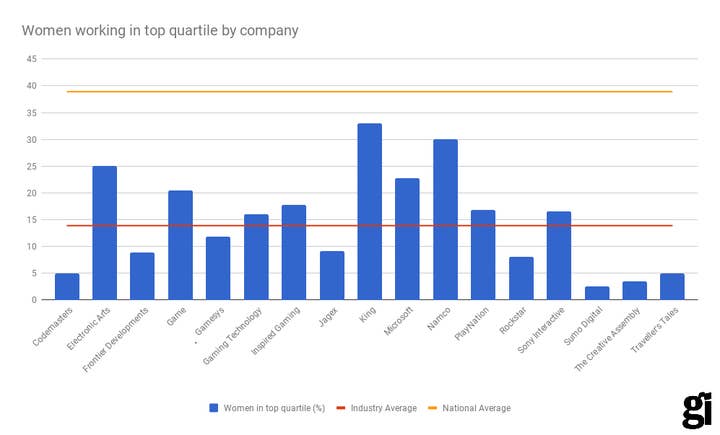
In the lowest quartile, the national split is 46.4% men compared to 53.5% women. In the games industry however, this figure is 72.7% compared to 27.3%. In the lower-middle quartile it is 50.6% men and 49.3% women nationally, compared to a dismal 77.8% and 22.1% respectively in the games industry. Upper-middle pay quartiles are no better with a national level 54% men to 45% women, compared to 83% men and 16.9% women in the games industry.
Sumo Digital had the lowest female representation in both the top and upper middle quartiles with only 2.5% in each. It was also below the industry average in the lower and lower-middle quartiles.
"We've been aware that our Gender Pay Gap is higher than we'd like," said Paul Porter, managing director of Sumo Digital. "While we've made great strides in recruiting more women to the junior-middle levels across the studios and are committed to addressing the imbalance at senior levels too, diversity remains important to us.
"We've already instigated a number of initiatives including the hiring of a new talent acquisition manager, who will be proactive in this area. We have a number of senior development vacancies and particularly encourage women to apply."
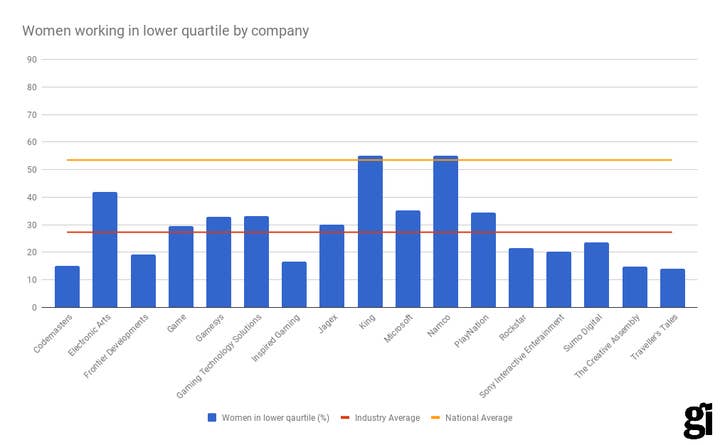
King and Namco were the only companies to buck this trend even slightly, with a higher than national average representation of women in the lowest pay quartile at 55% each. Namco is the most representative company overall, coming close to the national average for lower-middle with 47%, and upper-middle with 43%. Namco also performs better than most other companies in the upper quartile, but is still well below the national average.
Women in Games CEO Marie-Claire Isaaman, described the figures as "depressingly unsurprising." However, she disputed the fixation on female participation rate as "next to useless."
"It often obscures more than it reveals," she told GamesIndustry.biz. "For example, 19% of the industry workforce may be female but what exactly is it these girls and women do? The gender pay gap figures suggest the answer is: mostly not senior or boardroom roles."
Bonuses paint a very clear picture of the games industry as more generous than other sectors, though women still lose out to their male counterparts. The average percentage of the female workforce that receives bonuses across all sectors in the UK is 34.3% compared to 35.8% of men. Compared to the national average, in the games industry all but four companies paid out more bonuses to men, and all but five paid out more bonuses to women.
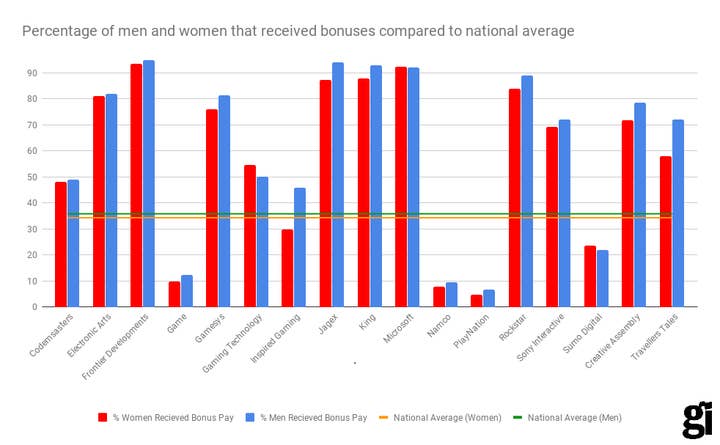
On average across the industry, women received 66p for every £1 a man received in bonus payments. Rockstar is by far the worst offender with women earning only 16p per £1 earned by a man through bonuses. In total 14 companies paid out bonuses to a higher percentage of their male staff than female staff, though it is the only area of the data where the disparity between men and women is less pronounced.

Several companies have responded to the data already. In a statement, Jagex said it "recognises the importance of a diverse workforce" and was aware that its wage gap was above the national median.
"However, this is not due to a pay equality issue, but as with the wider games industry, we have a lack of female representation in some disciplines across the studio, including leadership and STEM roles," the studio said.
TIGA CEO Dr Richard Wilson also highlighted the lack of women in STEM roles as a major issue facing the industry.
"We need to increase the supply of female students studying STEM subjects so that there is a larger potential pool of people which games businesses can recruit from. We also need to encourage more applications by women to work in our industry," he said. "We additionally need to retain and promote skilled women in our sector."
Electronic Arts, which has better gender representation in the four pay quartiles than industry average despite remaining well below the national average, said it has made "significant strides" in reaching a more balanced representation.
The publishing giant noted that the proportion of men and women receiving bonuses was comparable at 82% and 81% respectively. However, as demonstrated in the above chart, women earn only 55p to every £1 a man receives in bonuses, which is 11p below the industry average.
Rockstar, which was the second highest for median wage disparity, had the largest gap in bonus pay, and came well below the industry average for representation in all four quartiles.
"While our male and female employees are fairly compensated based on merit and without reference to gender, our gender pay gap is driven primarily by the structure of our workforce, with longer tenured employees who are predominantly male occupying our most senior roles," said studio director Andrew Semple.
"We are dedicated to continuing to build a representative gender balance across all our studio activities, and pledge to continue to find new ways to support and encourage women to both take up and advance in career opportunities in game developer in order to achieve that."
Ultimately, the wage gap data paints a damning picture of gender equality in the games industry, especially in relation to the rest of the UK. It is important to reiterate that while the data gives us no indication regarding equal pay for equal work, it does demonstrate a severe lack of women working at all levels of the industry.
Sharing her thoughts with GamesIndustry.biz, Wonderstruck game artist Jess Hyland noted that gender wage gap statistics lead only to more questions.
"Are women progressing through a company at the same rate as men, and if not what are the barriers to their progression?" she said. "Are women leaving companies or the industry altogether earlier in their careers than men do? Are senior-level women being hired at the same rate as senior men? Is maternity leave affecting women's career progression and what can be done about that? Are certain jobs perceived to be 'jobs for men' and certain jobs perceived to be 'jobs for women' and why might there be a disparity in pay between them?"
Author's note: Special thanks to Jess Hyland and Tom Clark for their help processing the data.
For the record: This article previously stated incorrectly that the industry median wage gap was 17.85%, rather than 15.3%. It has been corrected accordingly.


